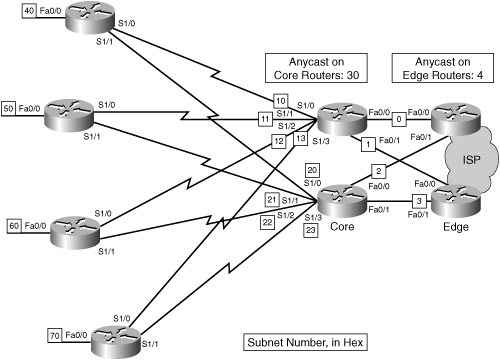The following scenario and questions are designed to draw together the content of the chapter and exercise your understanding of the concepts. There is not necessarily a right answer. The thought process and practice in manipulating the concepts is the goal of this section. The answers to the scenario questions are found at the end of this chapter.
Scenario 21-1
| Q1: | In Scenario 20-1, you assigned IPv6 addresses to a network. Figure 21-6 illustrates the network diagram and possible subnet assignments. In this scenario, provide the configuration commands to implement IPv6 and OSPFv3 in this network, using your address assignments.
[View full size image] 
|
Scenario 21-1 Answers
| 1:
| Example 21-11 provides a sample configuration for the top core router, using the subnet assignments in Figure 21-6 (as explained in Chapter 20).
Example 21-11. IPv6 Configuration of Top Core Router in Figure 21-6|
Code View: ipv6 unicast-routing
ipv6 cef
ipv6 router ospf 1
router-id 10.255.255.1
interface serial 1/0
ipv6 address 2001:1BE0:03A0:0010::1/64
ipv6 address 2001:1BE0:03A0:0030::1/64 anycast
ipv6 ospf 1 area 0
interface serial 1/1
ipv6 address 2001:1BE0:03A0:0011::1/64
ipv6 address 2001:1BE0:03A0:0030::1/64 anycast
ipv6 ospf 1 area 0
interface serial 1/2
ipv6 address 2001:1BE0:03A0:0012::1/64
ipv6 address 2001:1BE0:03A0:0030::1/64 anycast
ipv6 ospf 1 area 0
interface serial 1/3
ipv6 address 2001:1BE0:03A0:0013::1/64
ipv6 address 2001:1BE0:03A0:0030::1/64 anycast
ipv6 ospf 1 area 0
interface fastethernet 0/0
ipv6 address 2001:1BE0:03A0:0000::1/64
ipv6 ospf 1 area 0
interface fastethernet 0/1
ipv6 address 2001:1BE0:03A0:0001::1/64
ipv6 ospf 1 area 0
|
|









